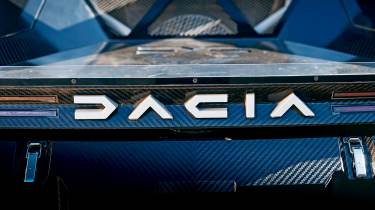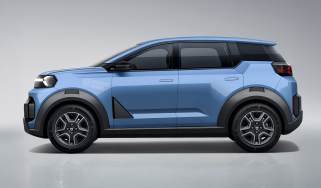Dacia Sandrider: Sebastien Loeb's Dakar rally challenger in detail
The new Duster is tough, but the Sandrider takes things to another level, as Dacia aims for victory on the punishing Dakar Rally
One hundred and fifteen miles per hour. If you’re hitting that on a track day, it’s pretty exciting. If you’re on a public road, then you better be in Germany on an autobahn, or you’ll be in a heap of trouble.
But if you find yourself at 115mph skimming the surface of a dirt track so bumpy and rocky that it felt severe enough to shake a road car to pieces at just 20mph when you drove along it just half an hour ago, then you know that you’re riding in a very serious machine. And there’s a very serious chauffeur to thank for the physical and emotional rollercoaster you’re going through.
The driver is Cristina Gutiérrez, the car is the Dacia Sandrider, and as a pair, they’re aiming for glory in the famous Dakar Rally in 2025 and beyond.
Few events in global motorsport provide a more severe test of car, driver and team than the Dakar. Two weeks and nearly 6,000 miles of racing through the Saudi Arabian wilderness take the cars over rocks, gravel and sand dunes. The rare, occasional sliver of asphalt must feel like bliss.
Temperatures can be sweltering during the day, and can take its toll on stages that run for hundreds of miles at a time. The harsh terrain multiplies the risk of punctures, mechanical failures and accidents, all of which can cost competitors minutes, or drop them out of the event altogether.
It’s of vital importance, then, for a new car to be tested to destruction before it turns a competitive wheel in anger. And we’ve caught up with Dacia for some insight into how development is proceeding. As we join the team, it’s pitching the car into endurance work within the grounds of Chateau de Lastours, a picturesque vineyard in the south of France that’s as well known for its off-road courses as it is fine wines.
We’re focusing on the dustier part of the chateau’s grounds. It’s a full day for Gutiérrez to get a solid test under her belt, but all three of Dacia’s hugely talented drivers are present.
Alongside the Spaniard, whose CV includes being the 2024 Challenger-class Dakar winner and the 2022 Extreme E Champion, Dacia is fielding five-time Dakar winner Nasser Al-Attiyah and a certain Sébastien Loeb, the most successful driver in World Rally Championship history. There are no half measures here, then.
“It’s a strong line-up, but the other teams also have strong line-ups,” says Tiphanie Isnard, Team Principal of the Sandrider project. “Toyota has a young rising driver [Guillaume de Mévius, 2024 Dakar runner-up], and the last Dakar was fantastic for them. Then there’s also Carlos [Sainz Snr, 2024 reigning Dakar champion with Audi, who will lead Ford’s campaign next year]. But for sure we are proud of ours, because it’s unique.”
Tiphanie has had the opportunity to build a new factory-backed team from scratch, and having worked alongside all three of her drivers at previous points in their careers, the pieces here fell perfectly into place. So far, testing is going better than she was hoping. “It has actually been surprising because we have had no big issue with our technical programme,” she tells us. “We have never had to stop the car. So far, so good!”
Dacia doesn’t have much racing heritage, so Tiphanie is running a team that is backed by motorsport royalty. Prodrive is an outfit that has won its class at Le Mans, has various touring car titles under its belt, and of course guided both Colin McRae and Richard Burns to WRC titles aboard Subarus that were developed and built at its base in Banbury, Oxfordshire.
While much of the Sandrider is new, it can trace its roots to the Hunter, a car that has finished second three times on the Dakar, and whose programme Prodrive has been running since 2023. Dacia and Prodrive aim to go one better next year.
We’re shown around the car by Al-Attiyah, who joined Dacia before seeing the Sandrider. “It’s a new project, and I have a lot of trust with Prodrive because I have a long-term relationship with the team,” he tells us. Al-Attiyah, whose five Dakar wins have come with three different manufacturers, believes that joining the team so early in its existence has been invaluable. “I have been able to put a lot of thoughts into the project from my experience,” he explains, “and the engineers really respect that a lot from a driver.”
Standing by the Sandrider for the first time, we see the look has been heavily inspired by the Manifesto concept that made its debut at the 2022 Paris Motor Show. Dacia hadn’t even committed to the Dakar project when that car was revealed, but its rugged looks and strong Dacia identity could be applied perfectly to the more intimidating Sandrider.
And boy, is it intimidating. It’s 2.3 metres wide, weighs roughly two tonnes and its all-black testing livery looks suitably evil. But there are practical touches to make things less gruelling for driver and co-driver, as Al-Attiyah explains how different the new creation feels from the Hunter. “It behaves better in the corners and jumps, but even inside it’s more comfortable,” he says. The dash is lower than the Hunter’s, which allows the seating position – and centre of gravity – to drop too. Even the door and windscreen seals have been improved so that less dust enters the cabin.
Another key practical touch is the ability to change tyres. Punctures are common, especially on the Hunter, whose exhaust position caused the rear tyres to overheat and fail. The Sandrider’s pipes take a different route, but if the worst does happen, strapping the 37-inch spare tyres to the side of the car makes them easier to access, while magnetic panels on the flanks can hold the bolts so they’re not lost to the sand. These changes have the potential to trim vital seconds off every tyre change.
The cabin is filled with digital screens that relay vital information such as tyre pressures, but also navigation instructions. That’s where the co-driver comes in; unlike in WRC, there’s no opportunity for the teams to check out the stage beforehand. All you have are a set of basic directions from the race organisers, sent to the teams just an hour before each stage.
So before we head out in the Sandrider, we get to brush up on our navigation skills and appreciate the role of the co-driver. We’re riding shotgun with Pablo Moreno Huete – who will be Gutiérrez’s navigator for the Dakar – in the passenger seat of a roadgoing Dacia Duster.
While the Sandrider has a digital display ahead of Huete’s seat, we’ve got an old-fashioned book to read from. The instructions are vague at best; as we set off, we’re describing arrows pointing to junctions, basic landmarks and the distances between them.
At a standstill it sounds fairly straightforward, as long as you reset the trip between each turn so that you can tell if the overall distance tallies with the route you’ve taken. But try doing it on hot, bumpy roads. Even at a steady 20-30mph it’s easily enough to throw you around to the point where you can lose your place.
Having found an even greater respect for the co-drivers, it’s time to feel the car for real. Gutiérrez, having just returned from a run, rolls the growling Sandrider into view. Safety gear acquired, we’re strapped into the snug cockpit.
Thankfully, there’s an intercom system for Gutiérrez to chat to us, because inside the Sandrider, the engine makes a busy, mechanical noise that’s loud even at idle. It’s not as tuneful as some high-performance road cars, but it’s a noise that only comes when engineers don’t have to worry about dampening the unpleasant clunks and crunches, instead focusing on performance.
Greetings exchanged, Gutiérrez rolls us towards the test stage. At low speeds, it feels like the Sandrider’s body hardly moves; in the short run from garage to track, pitch, dive and roll are virtually non-existent. After gently bobbling towards the course, Gutiérrez pulls a neat handbrake turn while changing the engine mapping from ‘road’ to ‘race’. And then she floors it.
Noise, drama and G-forces all hit you at once. By the standard of modern performance road cars, the straight-line speed isn’t so alien, but the fact that it’s possible on a loose surface without breaking traction is deeply impressive.
More spooky is what happens approaching the first corner. Gutiérrez hits the brake pedal as hard as one would in a racing car on smooth tarmac, and given the force with which I’m thrust into the harness, it’s stopping as if the surface is perfectly smooth asphalt, too. The inside wheels claw at the ground, finding grip and traction that you couldn’t imagine was possible in the conditions.
“Here’s a jump,” says Gutiérrez, sounding as calm as we’d imagine she sounds while talking to her patients in her second, more sedate career as a dentist. As the crest arrives and gravity seems to temporarily disappear, you can’t help but brace yourself in anticipation of a heavy landing. Instead, the Sandrider just hits the ground, all four wheels square, and without a hint of a bounce.
How can it do this? Most jumps it manages to land perfectly level, too, but even when it doesn’t, the twin-shock set-up at each corner manages to control the Sandrider’s vast body better than the average hatchback can manage over a gentle speed bump.
Learn to relax and let the car flow with the road, and you can really start to appreciate its performance, braking and, in particular, body control. In between the occasional bangs to the head, anyway. Yet look over to the driver’s seat, and Gutiérrez is serene. Her inputs are so smooth, in stark contrast to the noise and chaos that seems to be occurring everywhere else.
After 10 intense minutes of staggering car control, it’s time to clamber out of the narrow doors and chat to Gutiérrez in more sedate conditions. We’re keen to find out how the Sandrider compares with the Challenger T3-class cars she’s driven previously, as well as how it feels to be driving for a factory-backed team for the first time in her career. “Dacia comes with a big effort and a big team,” she says. “They want to win, and they are making a team with a winning car and drivers, so I’m happy that it includes me.”
Having teammates with such a huge amount of experience is also vital. “It’s an opportunity for me to learn [from Nasser and Seb] and also from the team,” Gutiérrez says. “From the first year of Extreme E [where she and Loeb were teammates], Sebastien was very nice with me. He was very open and he taught me a lot.”
That makes perfect sense in the world of Rally Raid. While in some motorsport categories, there’s an element of selfishness among teammates in order to gain a tiny advantage, in the Dakar, it’s vital to have a strong relationship. As Gutiérrez points out, “The Dakar is one of the more challenging races, and you need to have good teammates because you might need their help.”
Loeb was more than willing to help out, because he can’t wait to tick off one of the few events he hasn’t won in his staggering career. Nine World Rally Championship titles, an astounding 80 WRC event wins, plus victories in World Rallycross and the World Touring Car Championship – even a runner-up finish at Le Mans. Yet the Dakar is a race which has so far eluded the Frenchman. He’s finished second a total of three times, and last year he came third, after a late victory charge faltered in the closing stages. Loeb is finding the chance to get stuck into a serious factory-backed project an exciting prospect.
“I had different opportunities [for 2024 and beyond] but this one is the most exciting because I’m involved from the start,” Loeb tells us. “We have our common experience with Prodrive from the last Dakar we did, so we are used to working together and know our strong points and weak points. The Hunter is already fast, but we know it’s not perfect, so to create a new one with all of our experience, we have the possibility to make the best car that we can.”
As Al-Attiyah acknowledged, a clean-sheet design has allowed Loeb to add his input. “One of the things we wanted to change from the Hunter was that the visibility was not very good, but this one is much better. The chassis is new, the engine is new, and the electrical system is different. The suspension geometry is similar, but everything is much stronger. Now hopefully it will work.”
The toughness already looks encouraging, but Loeb agrees with Gutiérrez about just how great the Sandrider is to drive. “Now this car, you can drive it like a WRC car,” he enthuses. “You can play with it; you can be aggressive because it’s stable. It���s wide enough not to roll, as that was a problem on previous cars. Now you can really have fun in the driving, and we have tried to focus on the driveability and make it a bit more reactive [than the Hunter].”
Adding to the fun is that Loeb is being deliberately aggressive, and lacking much mechanical sympathy with the gearbox and suspension to try and break something. But reliability is strong compared with his previous campaigns, and this, in turn, has given the team the time and flexibility to make set-up tweaks. “Now we are satisfied with the differential, and the suspension is not far from it,” Loeb says. “However, we need to break the car at the earliest time possible, and for now it is being quite resistant!”
But with things going well so far in testing and team spirit fairly high, the Dacia squad will soon move on to more challenging testing schedules to try and aim for more reliability and performance.
It’s a project which Loeb is keen to continue for the long term, which explains his answer when we ask if the former gymnast will perform one of his trademark victory backflips from his WRC days. “It depends on how many years it takes to win,” he grins, “because maybe in 10 years I won’t be able to!”
Whether it takes Loeb a decade to break his Dakar duck, we predict that the Sandrider squad will be competing for wins from day one. And with such a strong car and driver line-up already in place, if Dacia doesn’t win, it’ll take an awfully special rival to beat it.
| FIA class: | Ultimate T1+ |
| Body: | Carbon fibre |
| Engine: | 3.0-litre V6, twin-turbo, direct injection |
| Power: | 360bhp |
| Torque: | 539Nm |
| Transmission: | Four-wheel drive |
| Gearbox: | Six-speed sequential |
| Suspension: | Double wishbone |
| Travel: | 350mm |
| Wheels: | 17-inch aluminium |
| Tyres: | BF Goodrich, 37 inches |
| Chassis: | Tubular |
| Size (L/W/H): | 4,140 x 2,290 x 1,810mm |
| Wheelbase: | 3,000mm |
| Overhang (f/r): | 590/550mm |
Find a car with the experts















